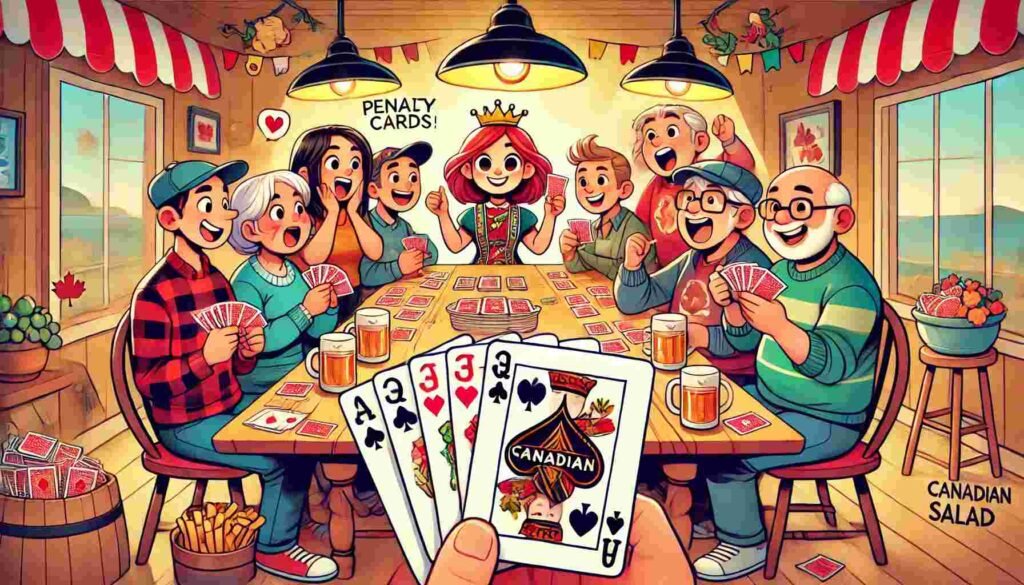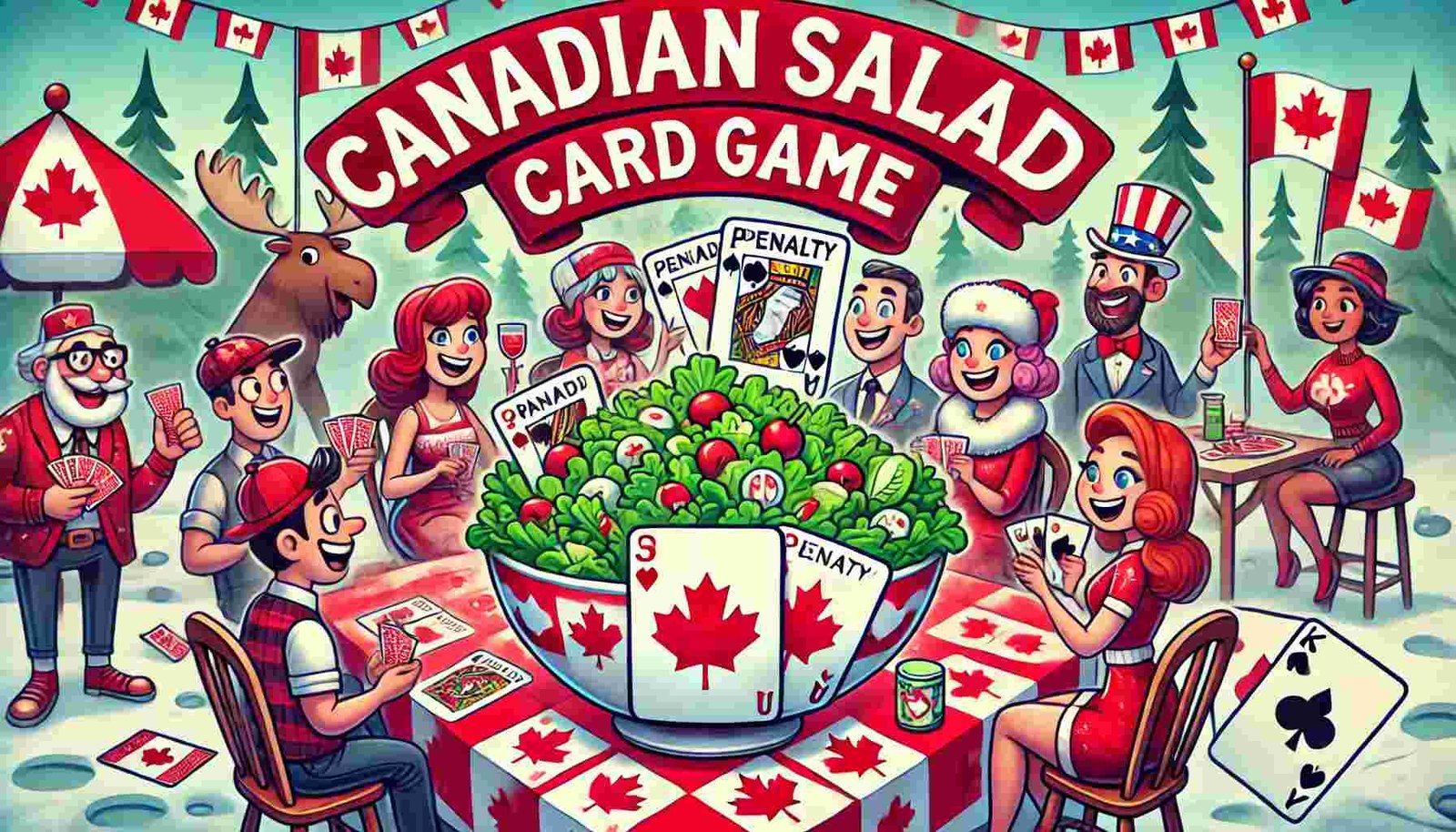Ready to crave something that challenges your strategy and keeps everyone on their toes? Say hello to the Canadian Salad card game—a chaotic, exciting mix of skill, luck, and friendly sabotage.
This unique game blends trick-taking mechanics with an ever-changing set of rules, making each round as unpredictable as the last. Whether you’re a seasoned card shark or just looking for a new family game-night favorite, Canadian Salad delivers fun in spades.
Table of Contents
What is the Canadian Salad Card Game?
The Canadian Salad card game is a multi-round adventure that spices up traditional card play. Each round introduces a new rule or objective, often forcing players to rethink their strategies. Think of it as a buffet of gameplay styles served up on one plate!
Why Is It Called Canadian Salad?
Much like a salad tossed with a bit of everything, this game is a blend of diverse challenges, that’s why the game is also called Fruit Salad and Salad Bowl. So, what’s the “Canadian” part? That’s just the cherry on top—a nod to its regional popularity.
Canadian Salad: A Unique Trick-Taking Card Game
The Canadian Salad card game is a trick-taking game style like Hearts and Spades, focusing on avoiding penalties by dodging specific tricks or cards. Unlike Euchre, it doesn’t involve bidding or trump suits, and it’s not a shedding game (like Crazy Eights) or a rummy-style game (like Phase 10 or Hand and Foot) that involves building sets or runs. Instead, its evolving objectives and penalty system make it uniquely engaging.

How to Play the Canadian Salad Card Game
Players, Cards, and Setup
Canadian Salad is designed for 3–6 players using a standard 52-card deck without jokers. The cards in each suit rank from Ace (highest) to 2 (lowest).
Setting Up the Deck Based on Players:
- 4 Players (Standard Game): Use all 52 cards; each player gets 13 cards.
- 3 Players: Remove the 2 of clubs; each player gets 17 cards.
- 5 Players: Remove the 2 of clubs and 2 of diamonds; each player gets 10 cards.
- 6 Players: Remove the 2 and 3 of clubs and 2 and 3 of diamonds; each player gets 8 cards.
- 7 Players: Use two decks of cards and remove one set of all clubs. Each player gets 13 cards.
- 8 Players: Use two decks of cards. Deal all cards evenly so each player gets 13 cards.
The game proceeds clockwise. To determine the first dealer, each player draws a card from the deck—the highest card deals. The dealer rotates to the left after each hand.
Gameplay Basics
The game is played in six rounds, each with specific objectives to avoid penalty points. Players must adapt their strategies in every hand.
General Rules of Play:
- The player to the dealer’s left starts by leading any card to the first trick.
- Players must follow suit if they can. If they don’t have a card in the lead suit, they can play any card.
- The highest card in the lead suit wins the trick.
- The winner of a trick leads the next card.
- There is no trump suit in Canadian Salad.
Scoring System
Each round has a unique goal to avoid penalty points:
- No Tricks:
Players aim to avoid winning any tricks.- Penalty Points: 10 points per trick.
- Total Points Available: 130 points.
- No Hearts:
Players try to avoid capturing any hearts.- Penalty Points: 10 points per heart.
- Total Points Available: 130 points.
- No Queens:
Players aim to avoid taking any queens in tricks.- Penalty Points: 25 points per queen.
- Total Points Available: 100 points.
- No King of Spades:
The goal is to avoid winning the King of Spades in a trick.- Penalty Points: 100 points for capturing the King of Spades.
- No Last Trick:
Players try not to win the final trick of the hand.- Penalty Points: 100 points for capturing the last trick.
- Combination Round:
All the rules from rounds 1–5 apply simultaneously.- Penalty Points: All previous penalties are tallied.
- Total Points Available: 560 points.
Grand Total Check: Across all players, the combined penalty points for the entire game should equal 1120 points.
Scoring Example
Let’s say the final trick of the Combination Round contains these cards: 10 of hearts, Ace of hearts, Queen of spades, and King of spades. Here’s how the scoring would work for the player who wins this trick:
- Hearts Penalty:
- 10 points for each heart (2 hearts: 10 + 10 = 20 points).
- Queen of Spades Penalty:
- 25 points for capturing the Queen of Spades.
- King of Spades Penalty:
- 100 points for capturing the King of Spades.
- Last Trick Penalty:
- 100 points for winning the last trick.
Total Penalty for This Trick:
20 (hearts) + 25 (Queen of Spades) + 100 (King of Spades) + 100 (last trick) = 245 points.
The player racks up a hefty 245 penalty points from just one trick in the Combination Round!
Winning the Game:
The player with the lowest total penalty points at the end of all rounds is the winner. The player with the highest points is the loser.

Canadian Salad Drinking Game
Transforming Canadian Salad into a drinking game adds an exciting twist for adult game nights. The trick-taking mechanics and penalty-driven rounds make it perfect for introducing fun (and responsible!) drinking penalties.
Drinking Card Game Setup
- Players: 3–6 players, as in the original game.
- Equipment: A standard 52-card deck, drinks of choice (beer, cocktails, or non-alcoholic beverages for inclusivity).
- Rules Adjustments: Each penalty in the card game translates into a drink or sip instead of points.
Gameplay
Each round follows the traditional Canadian Salad rules, but the penalties require players to drink instead of scoring points.
- Round Objectives:
- No Tricks: Every trick won = 1 sip.
- No Hearts: Each heart captured = 1 sip.
- No Queens: Taking a queen = 3 sips.
- No King of Spades: Capturing the King of Spades = a full drink.
- No Last Trick: Winning the final trick = a full drink.
- Combination Round: All the above rules apply simultaneously! Players might need to “pay up” multiple times for a single trick.
- Extra Drinking Rules:
- If a player forgets the round objective, they must take 2 sips as a penalty.
- If someone calls out the wrong lead suit, they take 3 sips.
- Optional: Introduce a “cheers round” at the end of each hand where everyone takes a celebratory sip.
Fun Challenges for Canadian Salad Drinking Game

Take your Canadian Salad drinking game to the next level with these innovative and funny twists!
1. The “Bartender’s Choice” Round
- How It Works: Before each round, one player is designated as the “Bartender.”
- Their Role: The Bartender can assign special drink penalties for certain cards. For example:
- Taking an Ace = finish your drink.
- Taking the 7 of Diamonds = mix a cocktail for someone else.
- Winning a trick with a face card = pass a drink to another player.
- Extra Twist: If the Bartender breaks the rules or forgets their own penalties, they must take a penalty shot!
2. “Salad Toss” Round
- How It Works: During this round, players are allowed to “toss” (pass) one of their penalty cards to another player.
- Example: If someone captures the Queen of Spades, they can toss it to another player, making them drink instead.
- Penalty for Tossing: Tossing costs two sips for the tosser, so use it wisely!
3. “Dressing Up the Salad” Rule
- How It Works: Add props or accessories (e.g., a silly hat or sunglasses) to the game.
- Rules:
- The first player to win a trick in any round must wear the “Salad Dressing” (props) until the next round.
- If the “Salad Dressed” player forgets they are wearing it, they take 3 sips.
- Bonus Rule: The wearer can pass the props to someone else by challenging them to win a specific trick.
4. “Shot for the King” Challenge
- How It Works: In the King of Spades round, the player who takes the King must pour a shot and drink it.
- Bonus Rule: They can challenge another player to a mini-game (like flipping a card to guess higher or lower). If the challenger loses, they drink the shot instead!
5. “The Cocktail Combo” Round (For the Combination Round)
- How It Works: For each penalty incurred in the Combination Round, players add a small amount of their drink to a communal glass.
- Endgame: Whoever finishes the round with the most penalty cards must drink the “Salad Cocktail” at the end of the round.
- Alternative: If you’re not into mixing drinks, replace it with a group “cheers and sip” penalty.
6. “Reverse Salad” Twist
- How It Works: Flip the objectives! For one round, the goal is to collect as many penalty cards as possible instead of avoiding them.
- Drink Rewards:
- The winner (with the most penalty cards) gets to assign drinks to other players.
- The loser (with the fewest penalty cards) takes a penalty shot.
7. “Wildcard Joker” Rule
- How It Works: Include the Jokers in the deck.
- Penalty:
- Drawing a Joker forces the player to take a shot and wear a “Joker Hat” (a silly accessory) for the next round.
- The Joker Hat wearer must take 1 sip for each card they play out of turn.
8. “Salad Roulette” Rule
- How It Works: Before the game begins, each player writes a funny or wild drinking rule on a piece of paper and places it in a bowl.
- At the Start of Each Round: Draw a rule from the bowl. For that round, the rule is in effect (e.g., “Players must say ‘yes chef’ before playing a card” or “Players must drink every time someone laughs”).
9. “The King’s Court” Rule
- How It Works: Whoever wins the King of Spades round becomes the “King” or “Queen” of the game.
- Royal Privileges:
- They can assign drinks to anyone for the rest of the game.
- Breaking a “Royal Decree” (e.g., “No laughing” or “Call me Your Majesty”) earns an instant 3-sip penalty.

Wisconsin Scramble vs. Canadian Salad vs. Texas Twister
The card games Wisconsin Scramble, Canadian Salad, and Texas Twister share a foundation of trick-taking gameplay with unique objectives in each round. Despite their similarities, regional preferences and house rules introduce notable differences. Here’s an updated comparison based on research:
1. Core Similarities
All three games involve:
- Trick-Taking Dynamics: Players compete to avoid penalty points by adhering to specific round objectives.
- Structured Rounds: Each game consists of multiple rounds with evolving rules, such as avoiding tricks, specific suits, or particular cards.
- Penalty-Point Scoring: Players aim to finish the game with the fewest penalty points to win.
2. Wisconsin Scramble
- Origins and Popularity: Commonly played in the U.S., particularly in Wisconsin. The name “Scramble” reflects the fast-paced, unpredictable gameplay.
- Key Features:
- Typically includes six rounds like Canadian Salad but may add bonus objectives such as avoiding specific tricks.
- Local house rules often encourage creativity, with players adding or modifying rounds to suit their group.
- Unique Variation: Some versions introduce a “scramble” round where all objectives are randomized for added chaos.
3. Canadian Salad
- Origins and Popularity: Invented in Canada, it’s the most structured and widely recognized version. The name emphasizes the “mix” of rules that shift with each round.
- Key Features:
- Six fixed rounds with clear objectives: no tricks, no hearts, no queens, no King of Spades, no last trick, and a combination round.
- Penalty points are consistent, making it easier to track scores across games.
- Gameplay Style: Ideal for players who prefer clearly defined rules and objectives.
4. Texas Twister
- Origins and Popularity: Played in parts of the southern U.S., the “Twister” name highlights the game’s chaotic and unpredictable nature.
- Key Features:
- Includes traditional rounds like Canadian Salad but frequently incorporates twists, such as reverse scoring (where penalty points in one round count as bonuses in another).
- Jokers are often introduced as wildcard penalty cards, adding more complexity.
- Unique Variation: Some Texas Twister versions include “hidden penalties,” where players reveal additional objectives at the end of a round.
Which One to Play?
- Choose Wisconsin Scramble for a creative, customizable experience.
- Opt for Canadian Salad if you want a structured, classic trick-taking game.
- Pick Texas Twister if you love chaotic and unpredictable challenges with added twists.

How Canadian Salad Compares to Other Card Games
While Canadian Salad shares trick-taking mechanics with many popular card games, it distinguishes itself with its evolving objectives and penalty-focused scoring. Here’s how it stacks up against some other well-loved games like Quodlibet, Crazy Eights, Hand and Foot, and Phase 10:
1. Canadian Salad vs. Quodlibet
Quodlibet is a versatile card game that blends elements of trick-taking and melding. Players aim to create specific sets or sequences while avoiding penalties or achieving specific objectives set for each hand.
- Similarities: Both games use a standard deck of cards and involve strategy to avoid specific outcomes.
- Differences: Quodlibet typically involves melding and set-building and isn’t limited to trick-taking. Canadian Salad, on the other hand, focuses solely on avoiding penalty points across multiple dynamic rounds.
2. Canadian Salad vs. Crazy Eights
Crazy Eights is a shedding game where players try to be the first to discard all their cards by matching the suit or rank of the top card on the discard pile. Special cards like eights act as wildcards, allowing players to change the suit.
- Similarities: Both games can be chaotic and fun, with rules that force players to adapt.
- Differences: Crazy Eights focuses on shedding cards by following suit or rank and introducing wildcards that disrupt gameplay, while Canadian Salad penalizes players for capturing certain cards or tricks.
3. Canadian Salad vs. Hand and Foot
Hand and Foot is a rummy-style game often played in teams. Players use multiple decks of cards to form melds (groups of the same rank) and earn points by “going out” (playing all cards from their hand and foot).
- Similarities: Both games can be played in teams and require players to keep track of scores across multiple hands.
- Differences: Hand and Foot is a rummy-style game that revolves around building melds and completing phases, while Canadian Salad focuses on trick-taking and avoiding penalties.
4. Canadian Salad vs. Phase 10
Phase 10 is a progressive rummy game where players complete specific phases (like creating sets or runs of cards) to advance to the next level. Each phase has unique requirements, and players must complete all phases to win.
- Similarities: Both games have a progressive structure where players face different objectives in each phase or round.
- Differences: Phase 10 revolves around completing pre-defined phases of card combinations, while Canadian Salad involves avoiding penalty cards and adapting to trick-taking objectives.
5. Canadian Salad vs. Euchre
Euchre is a fast-paced trick-taking game for 4 players in teams of two. Using a 24-card deck (9 through Ace), players bid to declare a trump suit and aim to win the majority of tricks. Points are scored for successful bids, with the first team to reach 10 winning the game.
- Similarities: Both are strategic and use trick-taking mechanics.
- Differences: Euchre relies heavily on trump cards and team play, while Canadian Salad uses penalty points to drive its gameplay.
| Game | Gameplay Focus | Scoring System | Key Difference |
| Euchre | Trick-taking & team strategy | Points for successful bids; first team to 10 wins. | Focuses on bidding and trump cards in team play. |
| Quodlibet | Trick-taking & set-building | Points for melds and tricks; penalties for failed tasks. | Combines melding with flexible trick-taking goals. |
| Crazy Eights | Card-shedding & wildcards | Penalty points for unplayed cards; target score loses. | Emphasizes shedding cards, no trick-taking involved. |
| Hand and Foot | Meld-building & team play | Points for melds; penalties for unplayed cards. | Team-based with a focus on rummy-style gameplay. |
| Phase 10 | Completing phases (combinations) | Penalty points for leftover cards; lowest score wins. | Progressive phases with fixed objectives. |
| Canadian Salad | Trick-taking & penalty avoidance | Penalty points for capturing unwanted cards or tricks. | Dynamic rounds with evolving trick-based objectives. |
These games blend strategy, adaptability, and a touch of luck to keep everyone engaged. With its unpredictable gameplay and moments of triumph (or hilarity), Canadian Salad guarantees fun for all. Ready to dive into a game that promises laughter, groans, and the occasional triumphant shout? Give Canadian Salad a try!
